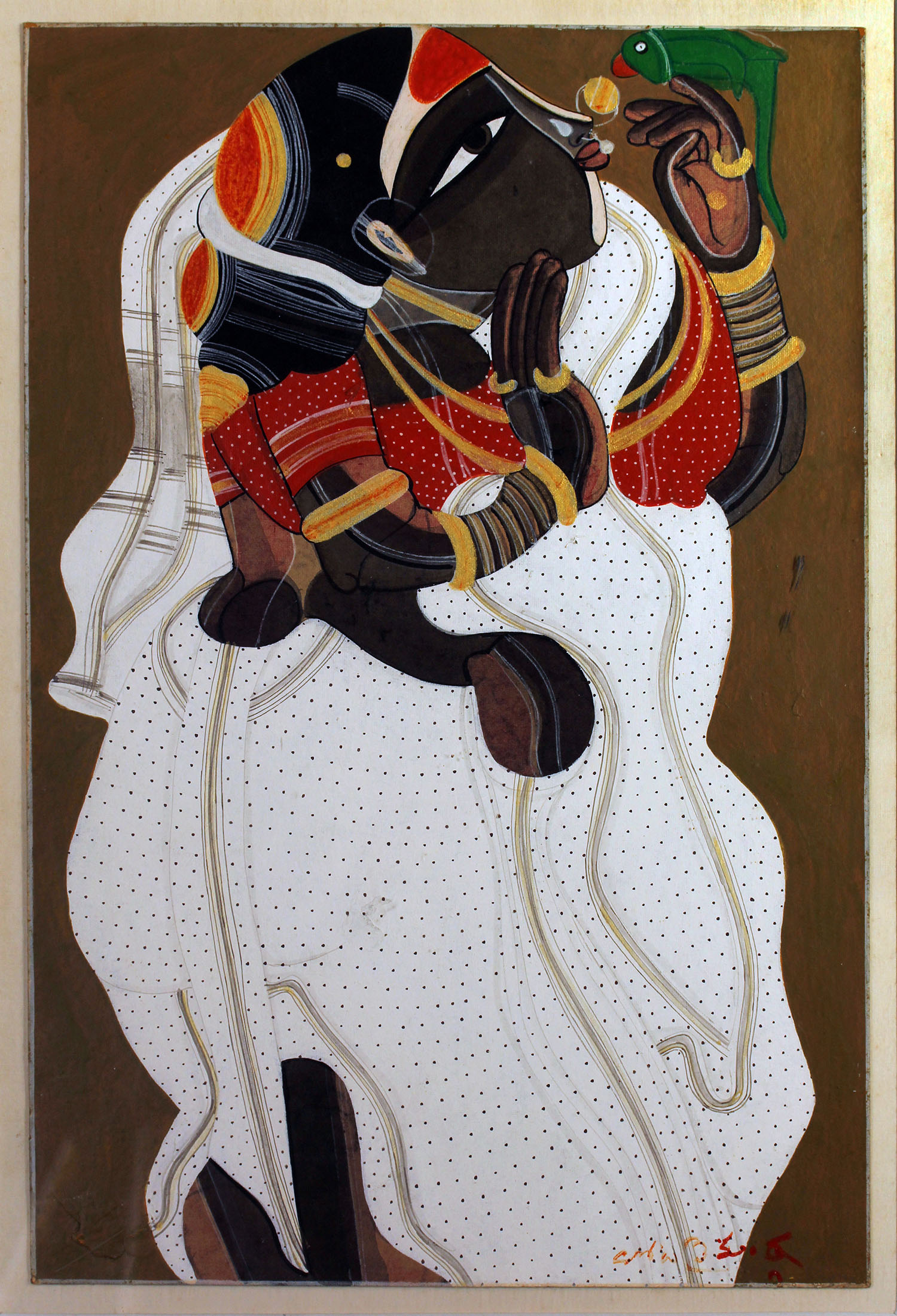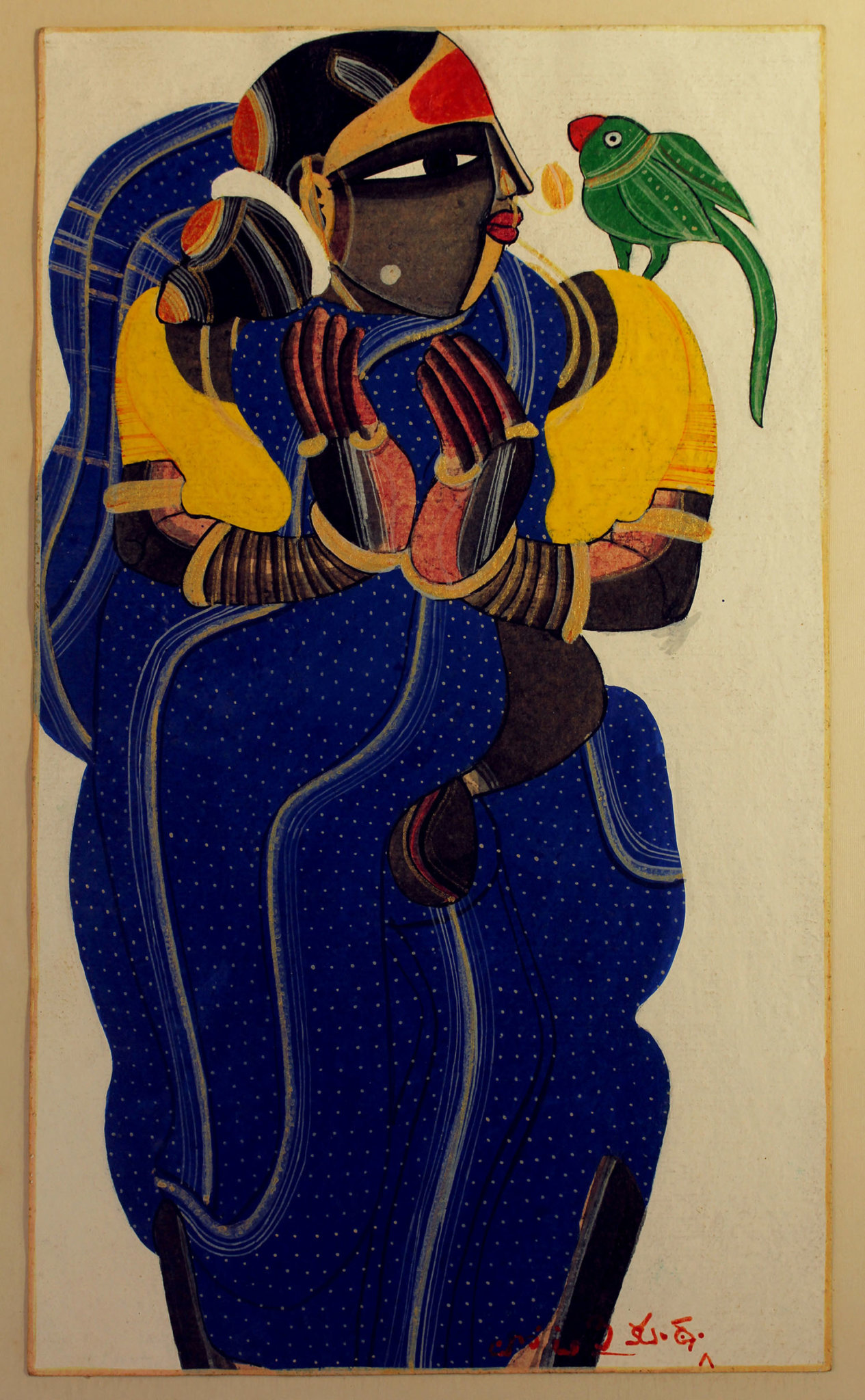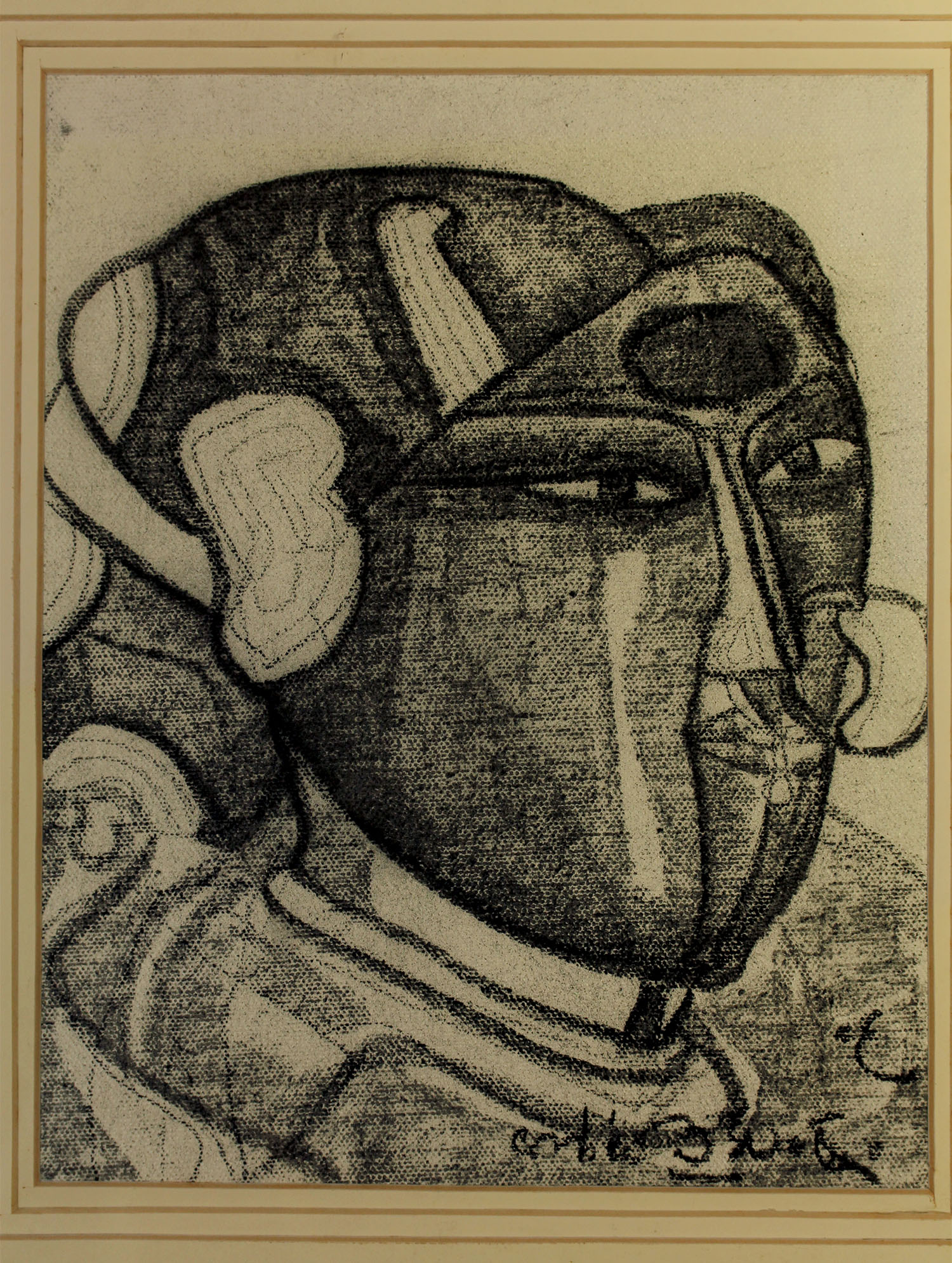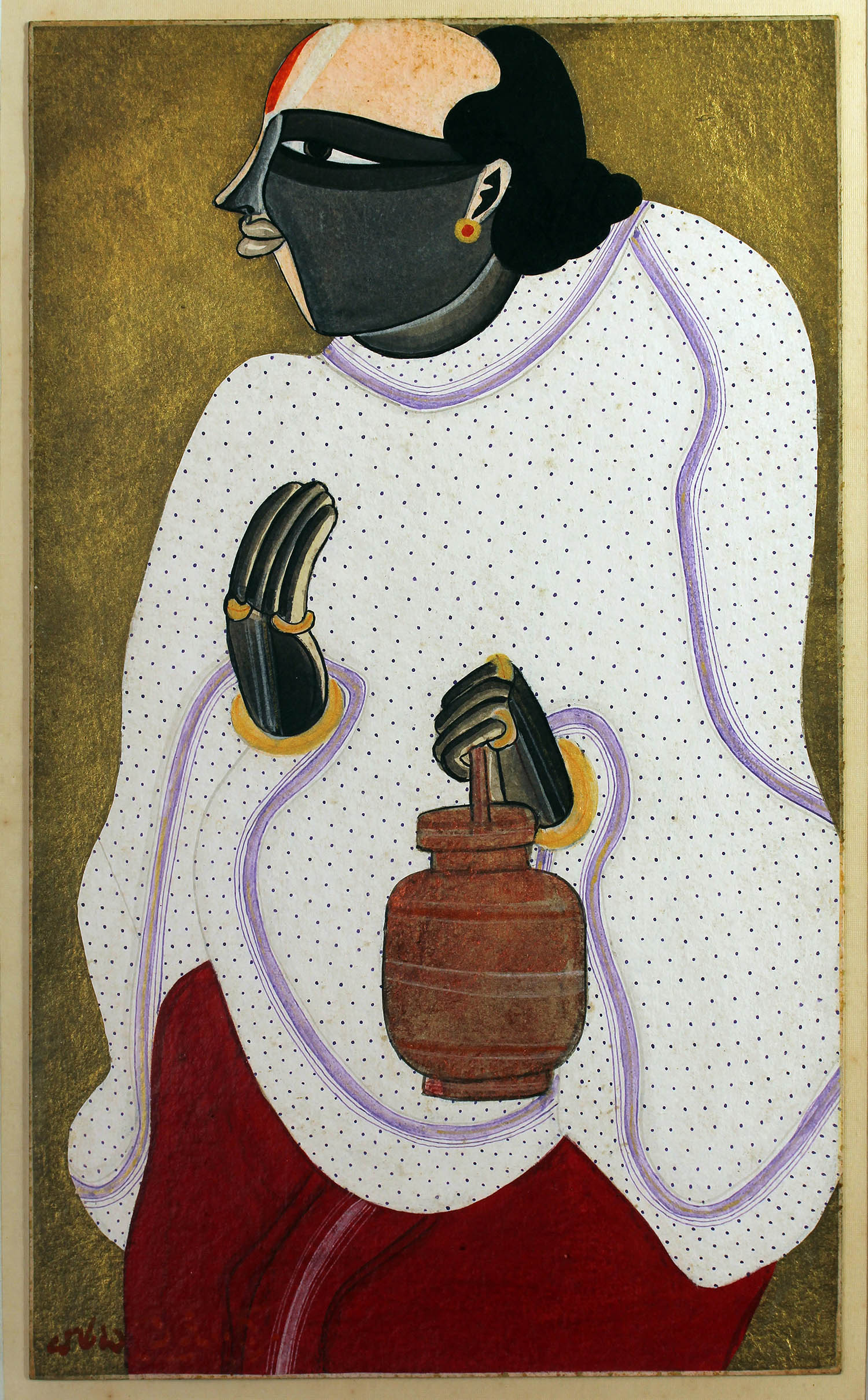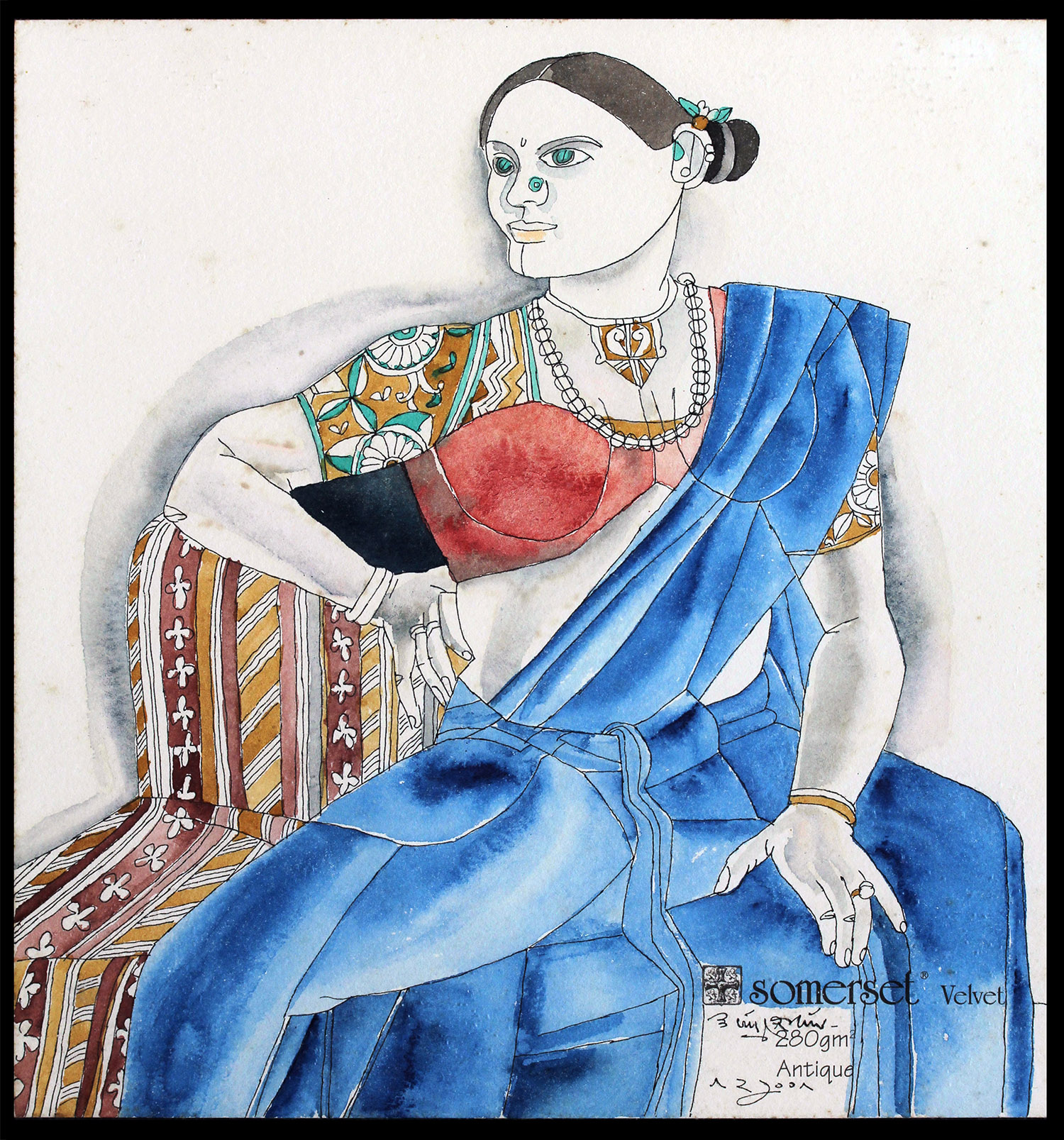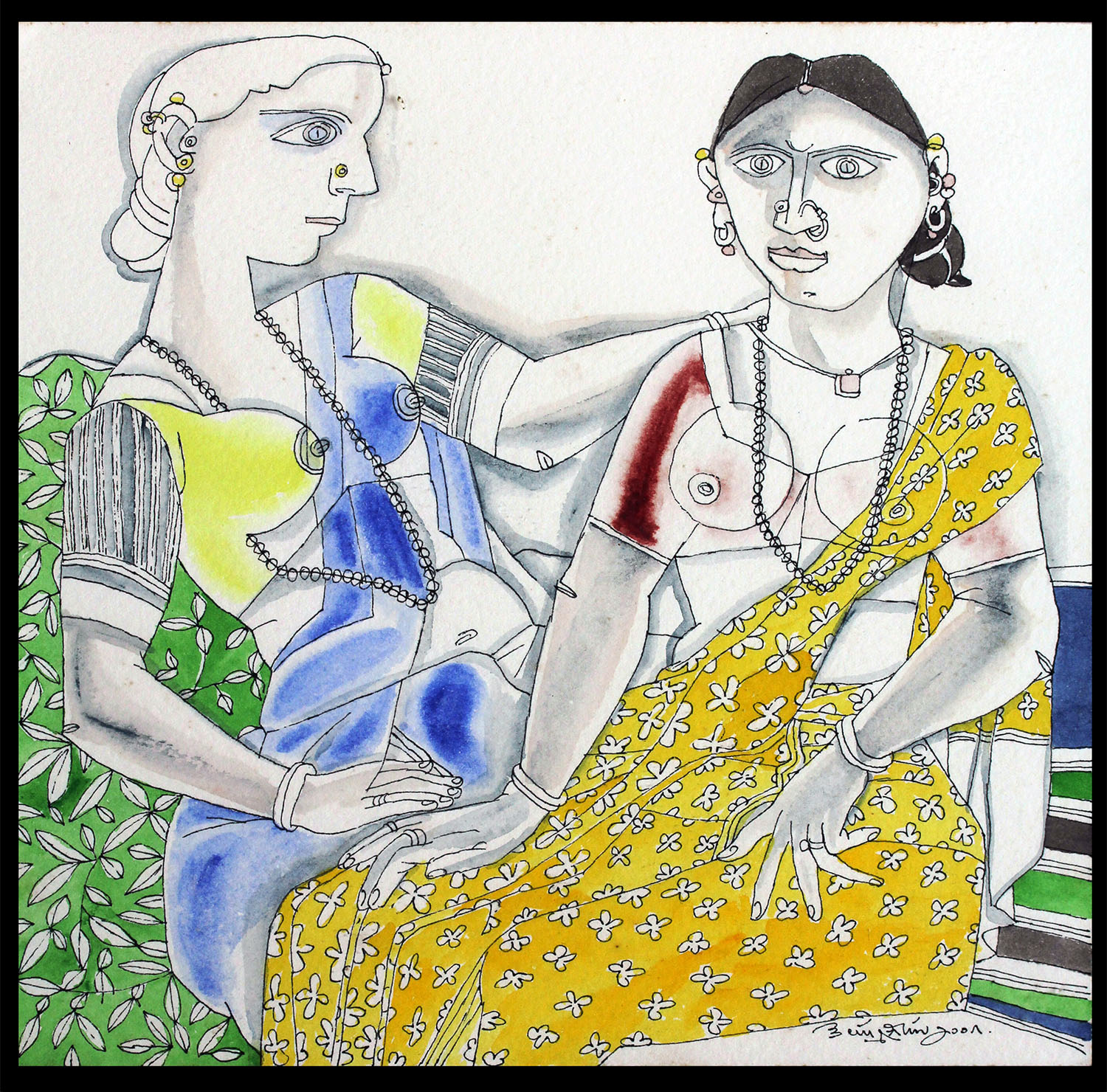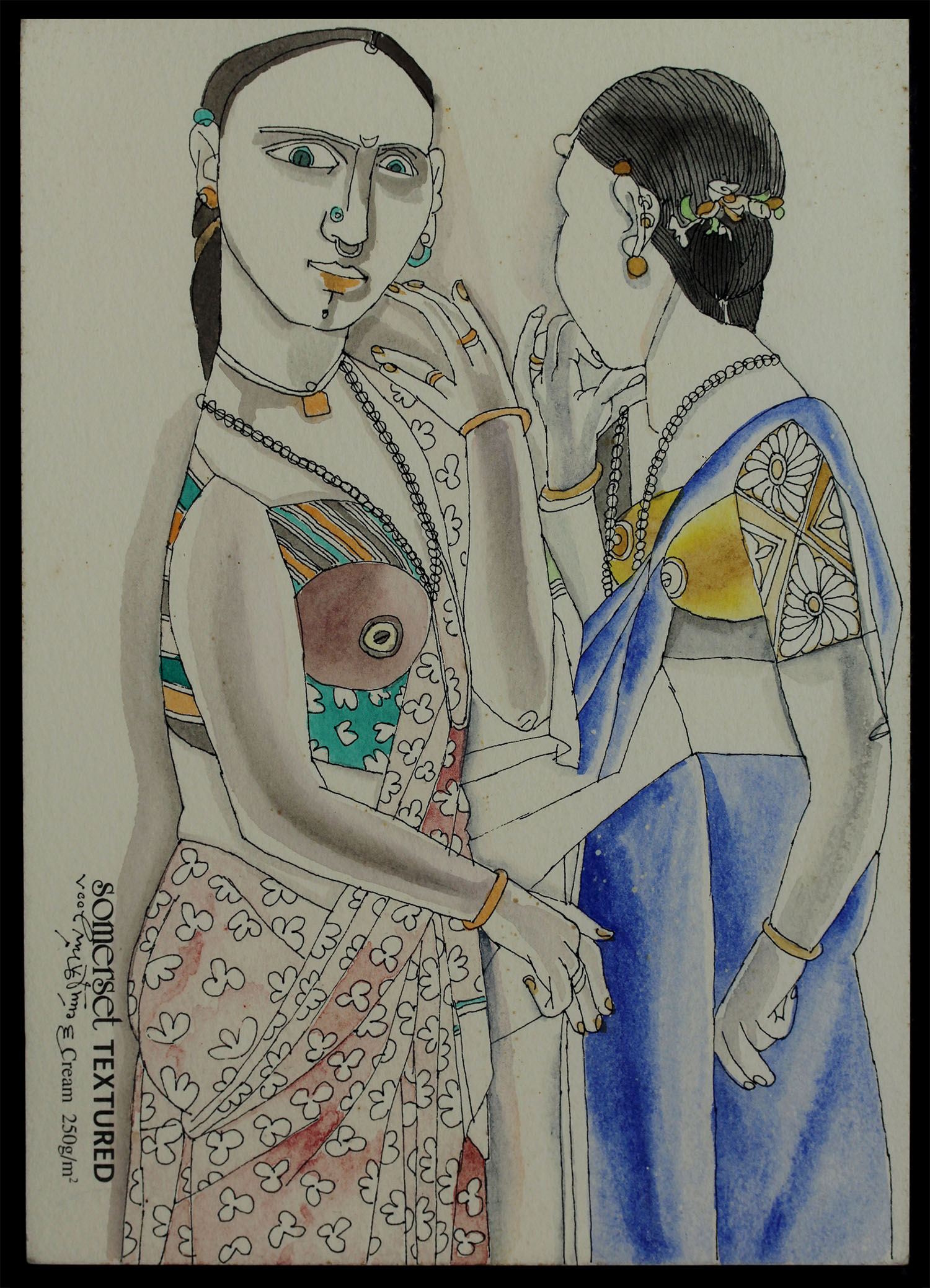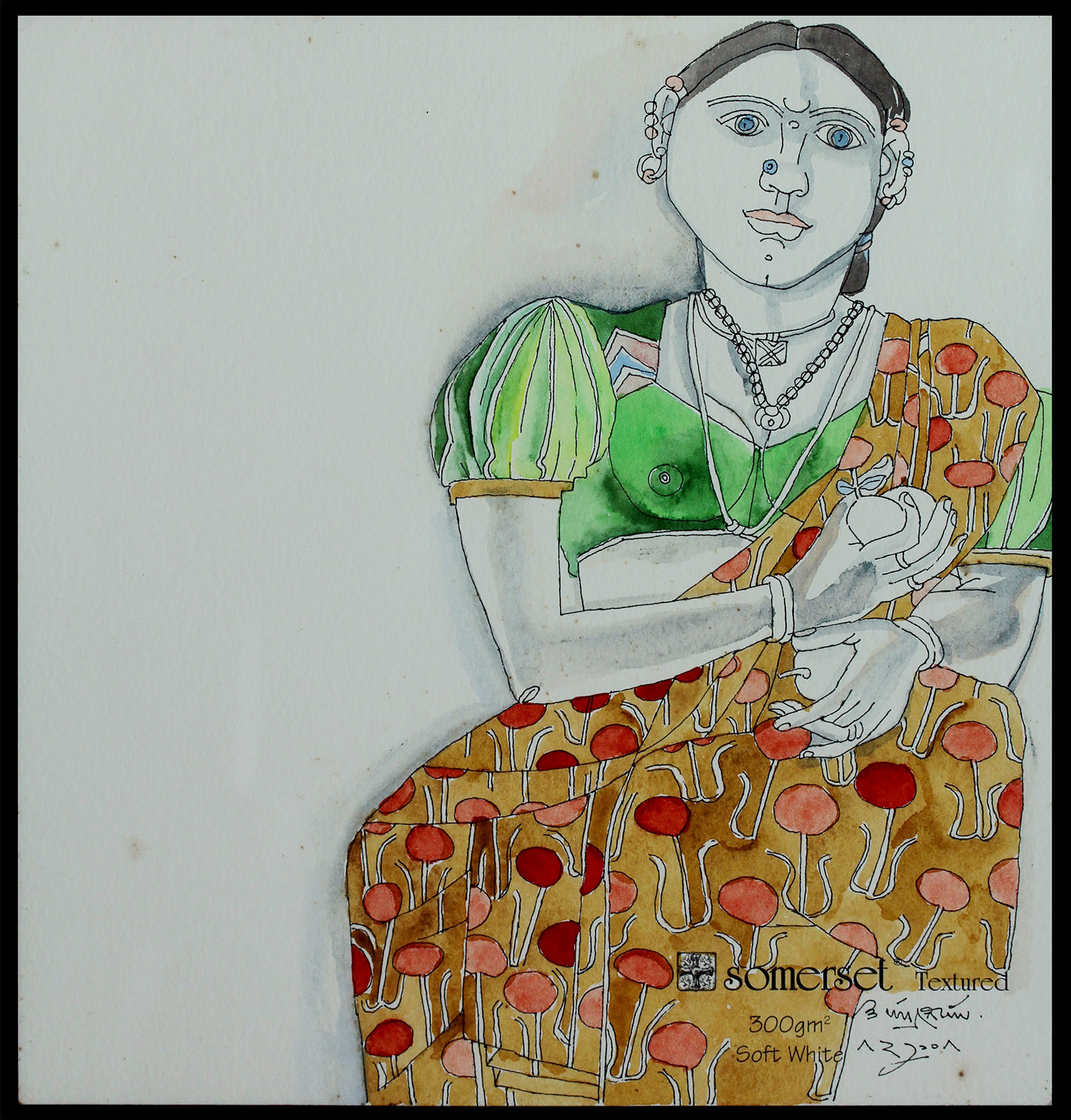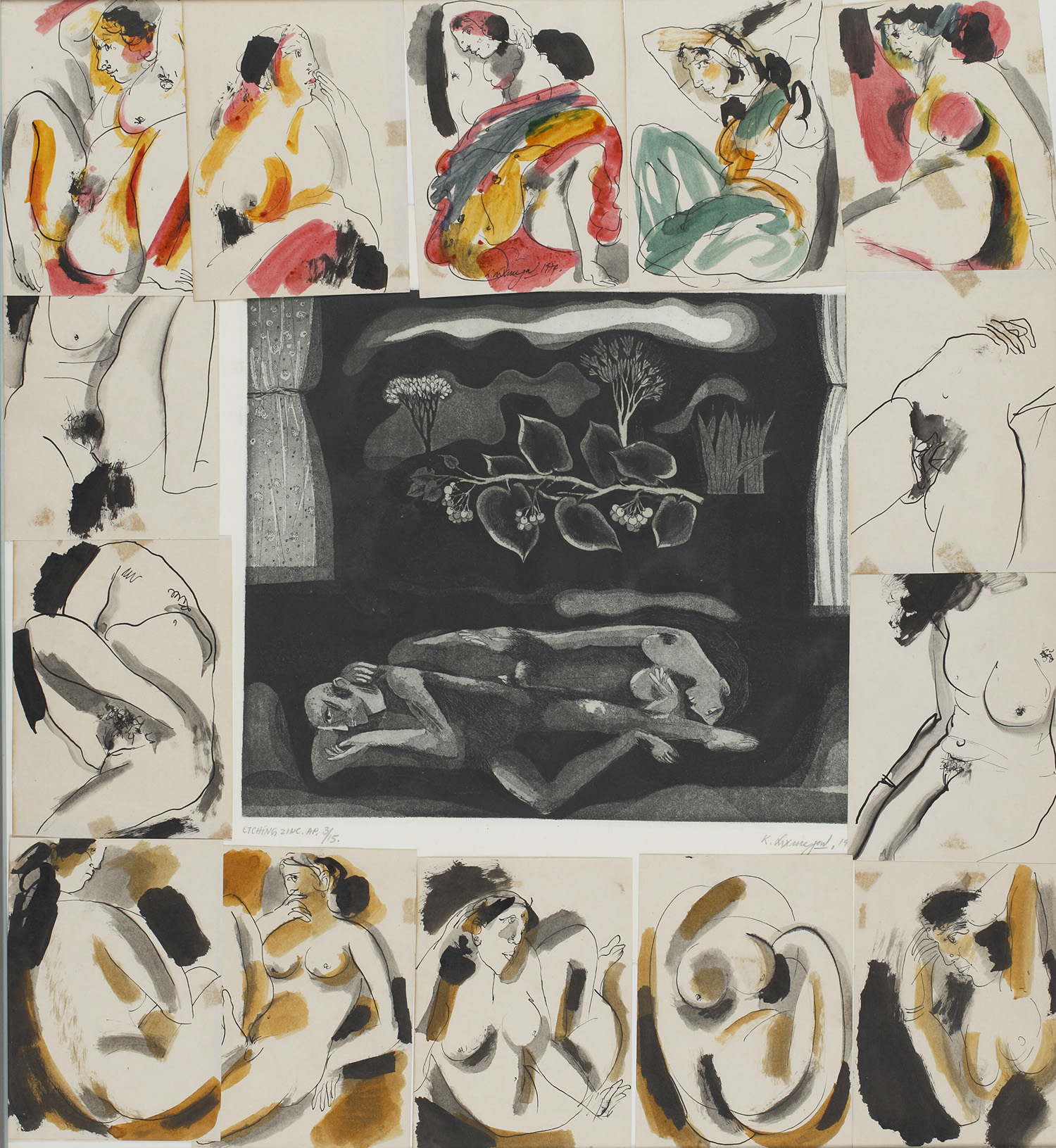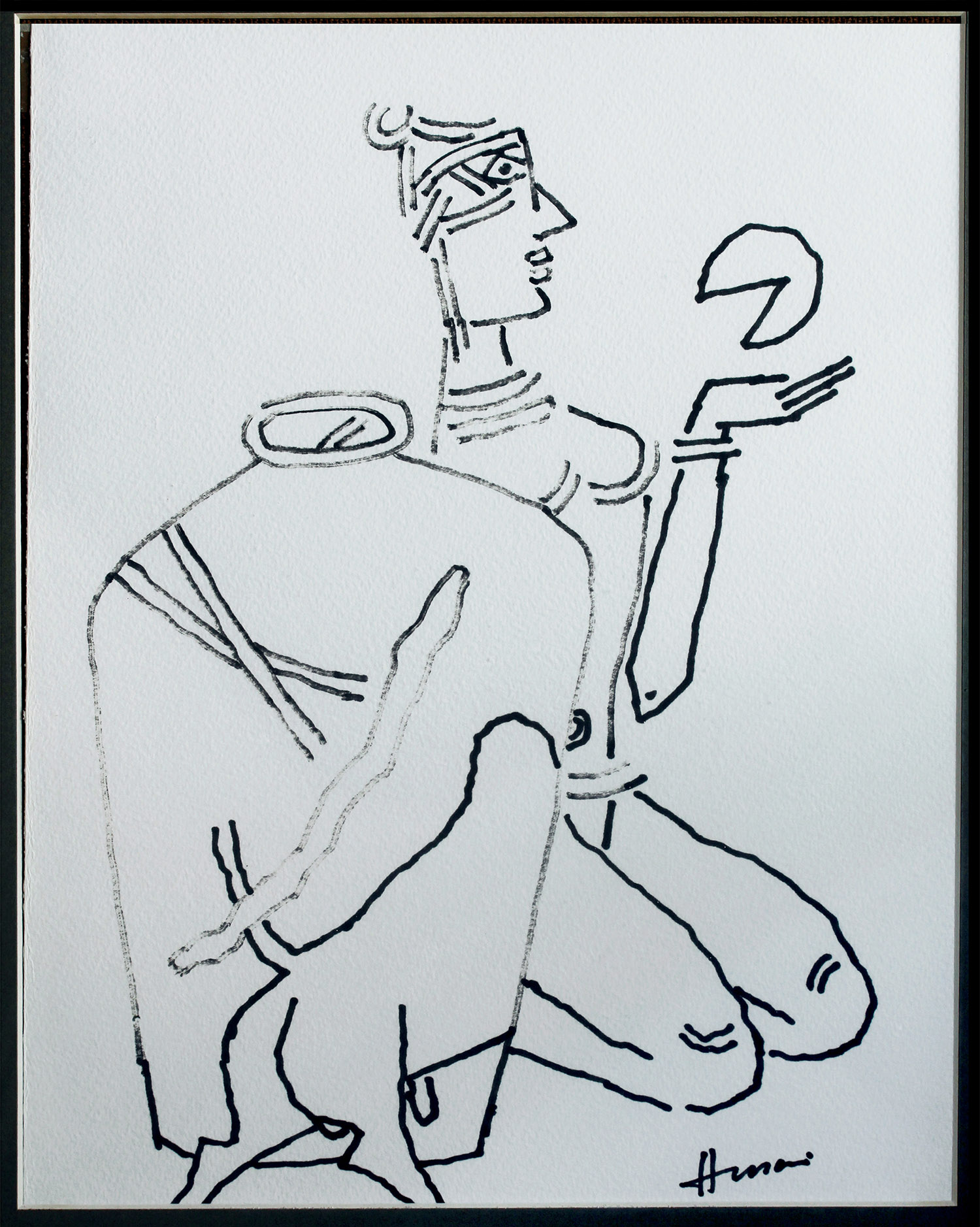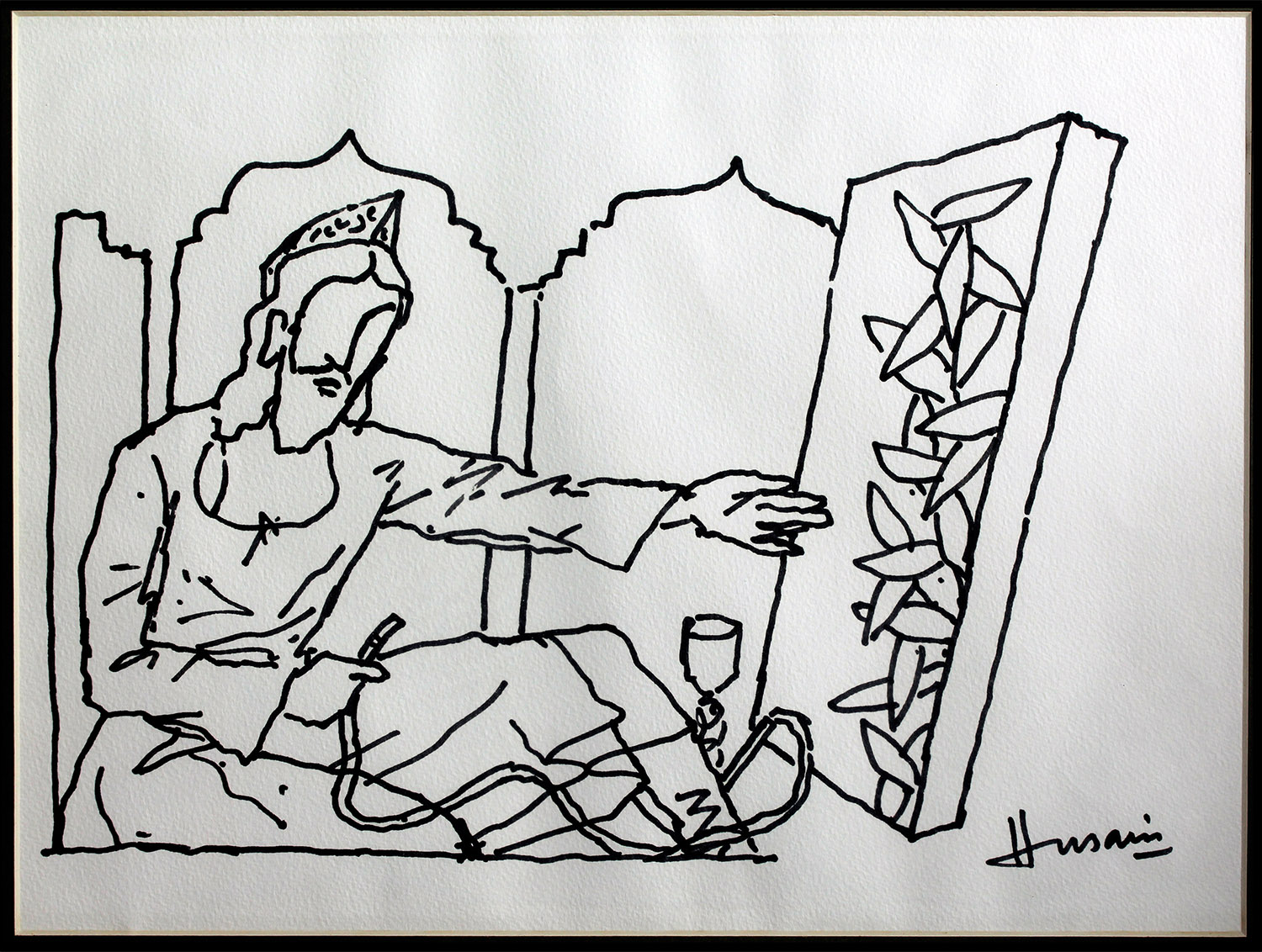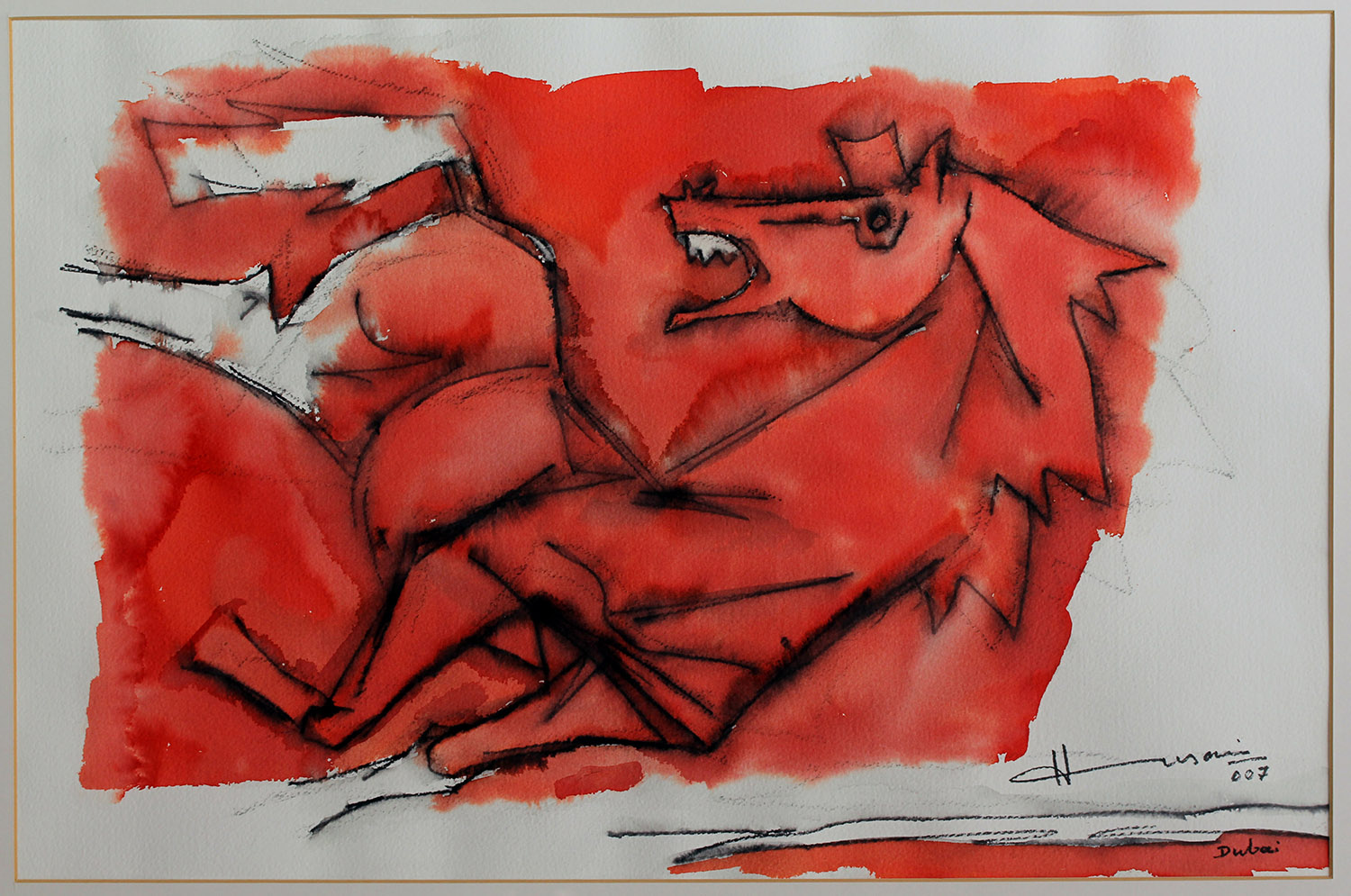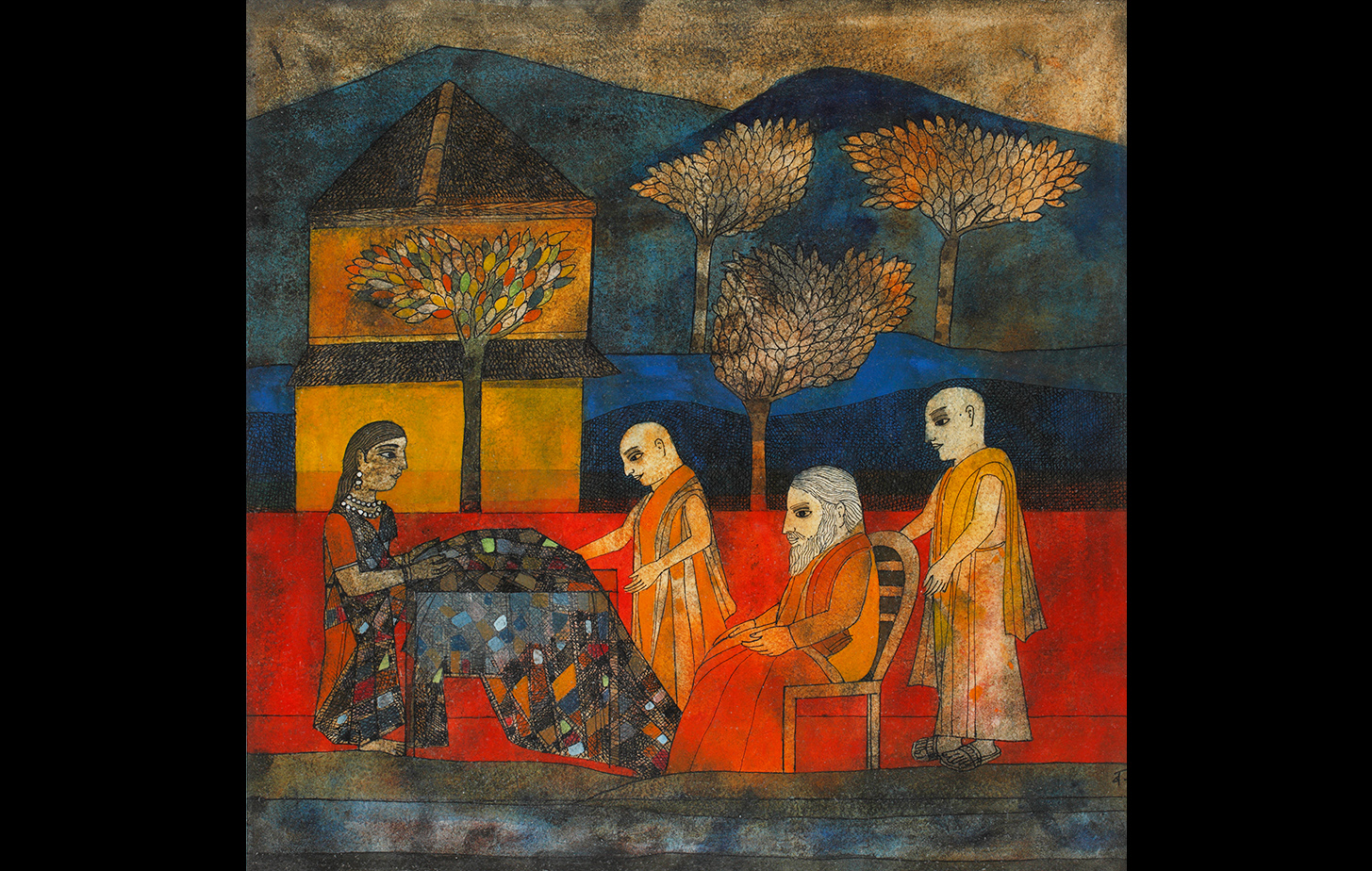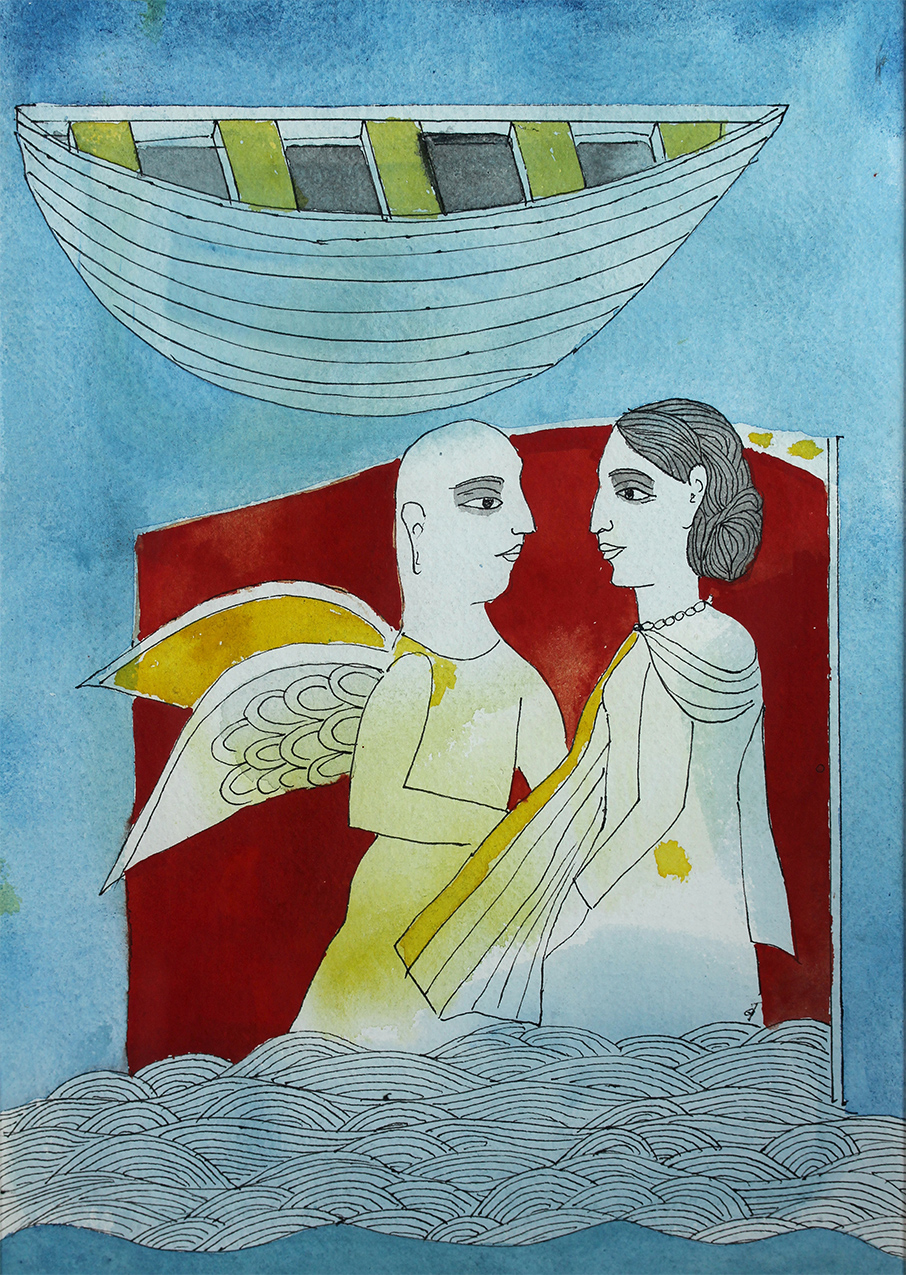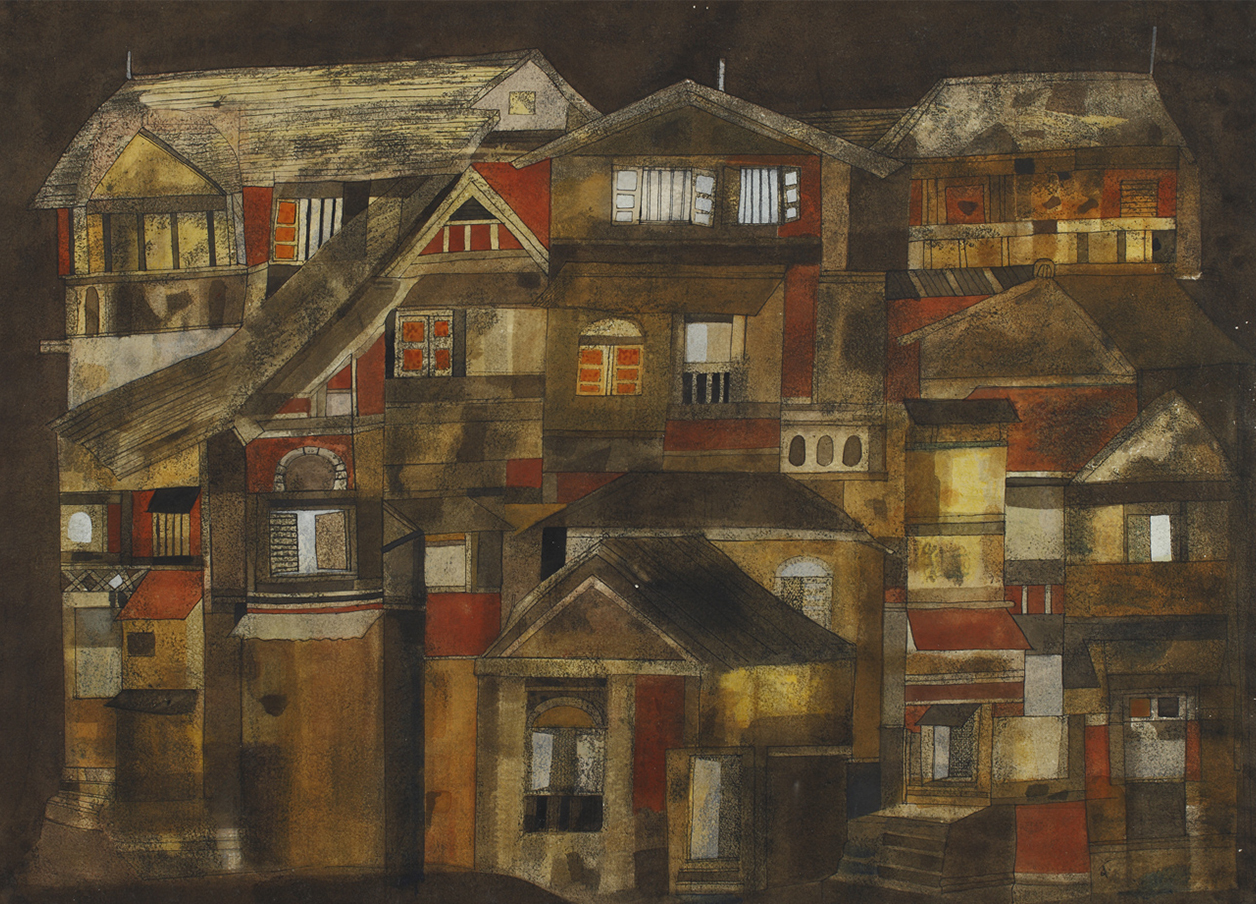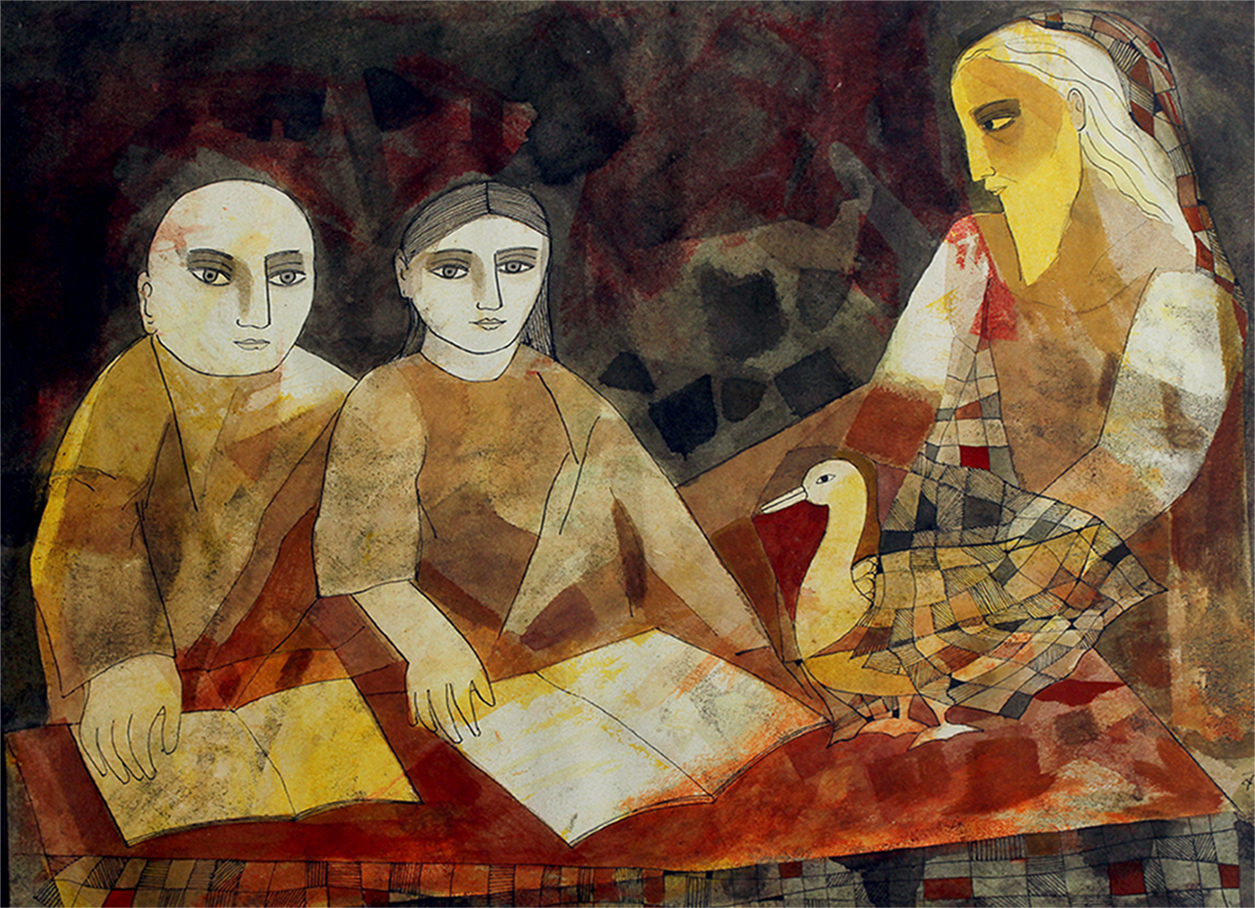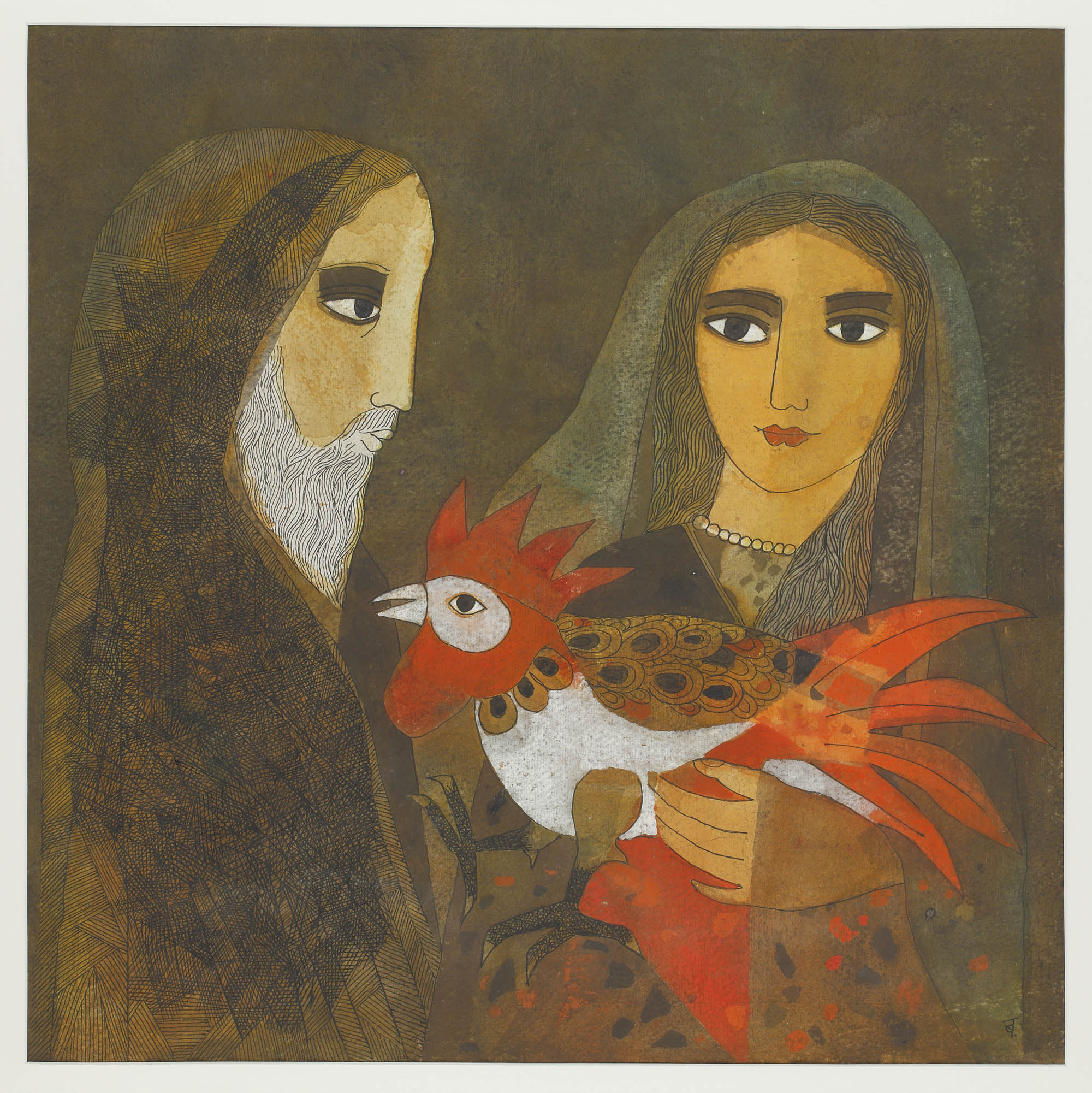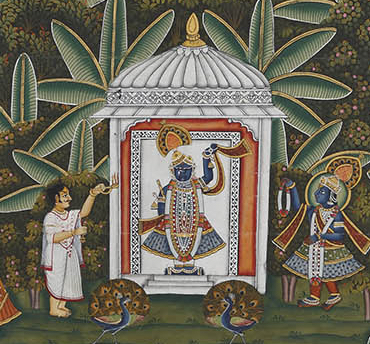A lot of Thota Vaikuntam’s art is inspired by the landscapes and people of the place where he grew up in rural Andhra Pradesh. Born in Burugupalli in 1942, Vaikuntam would go on to depict figures in his paintings based on actual people in his village. While the artist honed his technical skills first at the College of Fine Arts and Architecture in Hyderabad and then at MSU, Baroda, the faces, colours and textures of his homeland would form the heart of his creative expression.
The Sarmaya collection houses a varied series of works done by the artist using mediums such as charcoal on paper and paint on canvas. Each of these works displays a strong sense of control in terms of the quality of lines and the palette used. Vaikuntam’s more recent paintings tend to use a strict palette of bright and primary colors, paired along with defined brushstrokes. These help in bringing to life his sensuously rendered female figures, their dark skin and sturdy bodies hardened by labour, but softened by flowers and jewellery.
It’s immediately clear even with a cursory glance at Vaikuntam’s paintings that he was drawn to the female form. A profile in SaffronArt notes that he was “fascinated by the male artists who used to impersonate female characters in the travelling theatre groups that performed in his village. He admits finding the women of his village very sensuous and that he only attempts to capture their vibrancy.” His work does not aim to provoke the viewer into thinking that the female form should be idealized or fantasied; instead, he believes that his work derives its sensuous connotations from the deep traditions that form an integral part of Indian art and mythology.
While considering the works done by the artist with charcoal on paper, the viewer is able to observe a strong gradation in terms of color intensity as well as line quality. In these black and white portraits of women, Vaikuntam aims to focus on just the facial features of these Andhra women, without alluding to the contours of their bodies. These drawings almost seem like initial studies for his colorful paintings.
All three of these portraits are of traditionally dressed women, with large bindis, nose-rings and hair tied using gajras. These women appear to have rather distinctive features, almond-shaped eyes and strong sharp noses. Thanks to the lack of colour, the shading defines the intensity of the lines being used for the outline of the face.
In contrast, the brightly colored paintings of the same women offer a completely different perspective to the viewer. Here, the women represented are perceived to be modeled after the sculptures of alasa kanyas, popular forms found in medieval Indian temples. There is a more apparent sensual tone in these paintings with their voluptuous forms and their intimate communion with the parakeets perched on their shoulders. The two characters, human and animal, seem to be locking gazes intensely. Both the women and the birds could be seen as unabashed representations of human desire.
It is apparent from these two distinct sets of paintings that Vaikuntam is able to seamlessly combine two very separate styles of painting into one balanced oeuvre. While the painting style and motifs represented remain close to a traditional format of rendering, contextually, the themes being touched upon and the colour palette being used are largely contemporized.
Another major source of inspiration that informed Thota Vaikuntam’s work is a Hyderabadi landmark: the children’s cultural center, Jawahar Bal Bhavan. He taught art there for over fifteen years and has mentioned that he was greatly moved by the unabashed way in which children used colour. Their uninhibited pursuit of imaginary worlds and forms spoke deeply to the artist. To this day, Vaikuntam lives and practices in the city that proved to be such an influential, if invisible, part of his journey.
Like Thota Vaikuntam, K Laxma Goud too hailed from a village in Andhra Pradesh and passed through the portals of both the Government College of Fine Arts and Architecture in Hyderabad and MSU, Baroda. But the similarities end there.
Goud was born in Nizampur in 1940 and by the Late Sixties, he had established a reputation as an artist for his uninhibited nudes. His compositions often centred the sexuality of women and no amount of prudish criticism would change that. He did not care to appeal to a majority of the art audience of the time, who tended to be the upper middle classes. Eroticism would remain a dominant theme in Goud’s paintings, where men and women are often intertwined inextricably with each other.
Goud’s art often tends to put the viewer in the position of the voyeur. For instance, in the untitled etching of watercolor and ink on paper from the Sarmaya collection, Goud sketches erotic studies of the human female form around a black and white etching of a couple. The bodies carry an emotive charge too, not merely a sexual one. In his later works, the same figures are delineated with a much softer and more introspective outlook.
In his watercolor sketches from our collection, there’s a departure from the more obvious exploration of the erotic to a more subtle and nuanced style. Here, the women depicted are dressed in traditional Andhra clothing and jewellery, including the mangalsutra. There is an obvious yet flat use of color in each of these paintings. The skin of these women is left uncoloured, and only their clothes are filled out generously with colour. Goud has subtly highlighted certain features such as the eyes, hair and jewellery, to add character and life to each woman. There’s something strong and resilient about these characters, apparent in their ramrod straight posture and full-frontal stance. Even with a limited colour palette and a basic use of lines, Goud is able to convey his feminine ideal.
At 79, Laxma Goud currently lives and works in Hyderabad, a city that has always been close to his heart and his art.
MF Husain’s name is synonymous with the genesis of modern Indian art. Born in 1915 in Pandharpur, Maharashtra, Husain began his prolific career as an artist in Bombay where he helped to found the Progressive Artists’ Group. But there was another city that had an equally potent power over his vision.
The works that Husain created while he lived in Hyderabad in the Early Forties opened up a whole different perspective on the artist’s life. He often painted portraits and compositions of people that he encountered on a day-to-day basis. He was constantly painting, not bound or bothered by the pressures of creating something poignant. He was also never deterred or confined by surface mediums or materials, and painted on any make shift surface he could find using the most basic tools of rendering.
In 1942, Husain completed a series of drawings based on the nomadic tribes of Banjara Hills. He also spent a significant amount of time in Laad Bazar, near Charminar, where he would observe the various men and women who shopped for bangles and other trinkets. The black and white portraits in the Sarmaya collection are likely those of people Husain encountered during his stay in the city.
Especially the one of the man seated beside a large earthen pot, holding up a circular form with a piece missing. Even though this painting is just a contour line drawing of the person, there is a significant amount of detailing here. Husain was so proficient at his craft that he didn’t even need a wide colour palette or intricate compositions to engage his viewers.
In the contour-line portrait of the man in an angrakha and qawwali cap smoking a shisha also, there’s a wealth of detail. The sparse but elegant background is a nod to the minaret-studded skyline of Old Hyderabad. It is this ability to capture an everyday moment and add a layer of curiosity and emotion to it that makes Husain such a significant modern Indian artist.
Furthermore, for Husain, his life and his art were never two separate entities; in fact, they were more often indistinguishable from one another. Husain wasn’t just creatively stimulated by painting and drawing, but also had a keen interest in creating cinema. Early in his career, he painted billboards for many Hindi films. He nurtured a love for script writing, which would eventually lead him to writing and directing acclaimed films including Meenaxi: Tale of Three Cities. This Tabu-starrer was shot in three cities that were of great personal significance to Husain, and Hyderabad was one of them.
A lot of Husain’s works towards the end of his career dealt with religious subject matters, which got him into a lot of trouble with Hindu extremists in India, causing him to move to London in 2006. Sadly, in 2011 he passed away there too, far from the land he loved so well.
Badri Narayan was born in 1929 to a family from Secunderabad, the twin-city adjoining Hyderabad and the area where its army cantonment is located. A self-taught artist, Badri excelled in many roles over a 45-year career, ranging from writing to teaching to critiquing art. While he had his first exhibition of paintings in 1954 at the Hyderabad Art Society, Badri would eventually settle down in Mumbai even as his work travelled to shows around India and abroad, including international biennales of art in Tokyo and Paris.
Badri began expressing himself through ceramics and mosaics in the Late Forties, after which he moved onto exploring mediums like ink, watercolour, pastels and paint. His artistic vocabulary comes from his curiosity of medieval woodcuts, Byzantine portraiture, Ajanta murals and Pahari paintings. Badri’s works always tend to have a strong narrative. In both his portraits and landscapes, many of which are part of our collection, there are stories being told.
In the ink-and-watercolour landscape, Badri depicts a cityscape with houses almost stacked one on top of the other. Even though there is no evidence of human-life in this painting, the artist subtly alludes to the presence of life with a lit window here, a mysterious shadow there. This painting has a deeply introspective gaze with a special attention to detail.
In his figurative paintings such as Kukkuta Jataka, Maya Displaying her Veil of Many Colours and Letter of Dream, Badri constantly alludes to fables and mythologies of the larger Subcontinent. Buddhist themes especially featured heavily in his paintings and this might well have been the silent influence of his birthplace asserting itself; the state of Andhra Pradesh has over a hundred sites sacred to Buddhism and a gigantic statue of Buddha looms Statue-Of-Liberty-like in the heart of its erstwhile capital, Hyderabad. Over the course of a career that won him many awards not to mention a national honour in the form of the Padma Shri, Badri left his hometown behind but a part of its spiritual aura seems to have stayed with the artist.
References from the Sarmaya Library
- A Visual History of Modern Indian Art, Volume 8, Region and Identity, Cholamandal Artists’ Village, Modernists of the South. Delhi Art Gallery. Pgs. 1546-1556, 1556-1560, 1578- 1580.
- A Visual History of Indian Modern Art, Volume 9, The Sacred and The Sensual, Neo Tantra, Erotic Art. Delhi Art Gallery. Pgs. 1678-1688, 1688-1694.
- Delhi Art Gallery (Modern), Auction Catalogue, Auction of Indian Modern Art, Mumbai, April 02, 2016.
- Delhi Art Gallery, Auction Catalogue, Indian Modern Art, Auction – Mumbai, April 22, 2015.
- F. Husain ‘Where Art Thou’, an autobiography, with Khalid Mohammed, including sketches by M.F. Husain, Chapter ‘Hyderabad’s Laad Bazaar’, Pg. 137-143.

